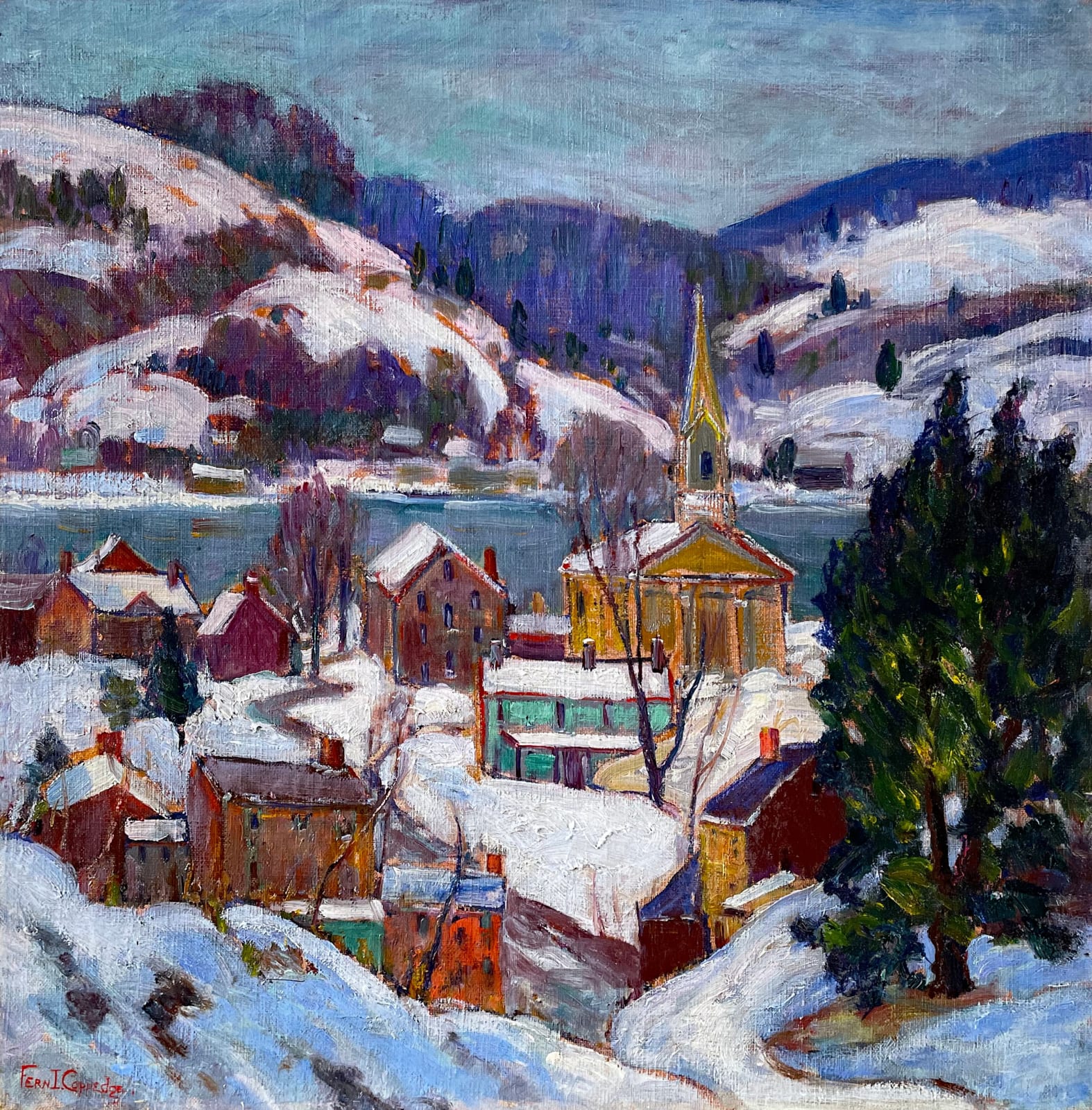Fern Isabel Coppedge 1883-1951
New Hope Hills, c. 1931
Oil on canvas
16 x 16 inches (40.6 x 40.6 cm)
Framed dimensions: 22 1/2 x 22 1/2 inches
Framed dimensions: 22 1/2 x 22 1/2 inches
Signed lower left: Fern I. Coppedge
Fern Isabel Coppedge is arguably the most unique and unusual of all the Pennsylvania Impressionists. She studied under many different teachers, including William Merritt Chase and Daniel Garber, and attended...
Fern Isabel Coppedge is arguably the most unique and unusual of all the Pennsylvania Impressionists. She studied under many different teachers, including William Merritt Chase and Daniel Garber, and attended numerous art institutions, such as the Art Institute of Chicago and the Pennsylvania Academy of the Fine Arts. Yet Coppedge’s work was not remotely derivative, and she developed a distinctive painterly voice that went far beyond the relatively traditional training that she received. She once remarked how even as a child, she always saw the world differently: “People used to think me queer when I was a little girl because I saw deep purples and reds and violets in a field of snow.”1
Coppedge first visited New Hope in 1917, and three years later, she moved to Lumberville, Pennsylvania, where she purchased a home near Garber’s residence. Like the other members of the New Hope School, Coppedge was a plein-air painter and preferred to work directly from nature. However, she did not restrict herself to a literal translation of it. Rather, her paintings depart from the realist tradition and take on a highly personal note, particularly due to her use of an iridescent and vibrant palette. Her broad brushwork and flat application of paint are vastly different from the short, broken brushwork of French Impressionism and owe more to the influence of the Fauves.
Coppedge is best known for her winter and autumnal views of the New Hope landscape, and New Hope Hills a splendid example of the artist’s best work. Her innovative use of color in combination with the glowing white of the snow creates a composition that is as dynamic as it is original. Occasionally, she even refrained from mixing colors on the palette, preferring instead to load the pure pigment directly onto her brushes right from the tube. Indeed, over the course of her career, her color became rooted less in nature and more in her imagination. The New Hope modernist Lloyd Ney praised her late paintings for this quality, remarking: “Here in these later works we see a purity of color, a sparkle of pigmentation that takes it farther away from the imitative.”2 Coppedge’s compositions also became less naturalistic as she grew increasingly interested in flattening elements of her pictures to create an overall decorative sense of pattern. This quality is particularly evident here, in which the trees are painted in an almost folk-like manner, with their branches entwining playfully across the canvas and reaching up into the sky.
1 Fern Isabel Coppedge quoted in Brian H. Peterson, ed., Pennsylvania Impressionism (2002), p. xii.
2 Lloyd Ney quoted in Thomas C. Folk, The Pennsylvania Impressionists (1997), p. 106.
Coppedge first visited New Hope in 1917, and three years later, she moved to Lumberville, Pennsylvania, where she purchased a home near Garber’s residence. Like the other members of the New Hope School, Coppedge was a plein-air painter and preferred to work directly from nature. However, she did not restrict herself to a literal translation of it. Rather, her paintings depart from the realist tradition and take on a highly personal note, particularly due to her use of an iridescent and vibrant palette. Her broad brushwork and flat application of paint are vastly different from the short, broken brushwork of French Impressionism and owe more to the influence of the Fauves.
Coppedge is best known for her winter and autumnal views of the New Hope landscape, and New Hope Hills a splendid example of the artist’s best work. Her innovative use of color in combination with the glowing white of the snow creates a composition that is as dynamic as it is original. Occasionally, she even refrained from mixing colors on the palette, preferring instead to load the pure pigment directly onto her brushes right from the tube. Indeed, over the course of her career, her color became rooted less in nature and more in her imagination. The New Hope modernist Lloyd Ney praised her late paintings for this quality, remarking: “Here in these later works we see a purity of color, a sparkle of pigmentation that takes it farther away from the imitative.”2 Coppedge’s compositions also became less naturalistic as she grew increasingly interested in flattening elements of her pictures to create an overall decorative sense of pattern. This quality is particularly evident here, in which the trees are painted in an almost folk-like manner, with their branches entwining playfully across the canvas and reaching up into the sky.
1 Fern Isabel Coppedge quoted in Brian H. Peterson, ed., Pennsylvania Impressionism (2002), p. xii.
2 Lloyd Ney quoted in Thomas C. Folk, The Pennsylvania Impressionists (1997), p. 106.
Provenance
The artist;Gift from the artist to George and Grace Perry, ca. 1931 (likely a wedding present);
By descent in the family, until 2025
